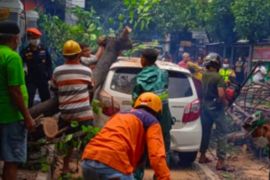He urged the head of the Meteorology, Climatology, and Geophysics Agency (BMKG) to provide detailed information to serve as a guideline for fast and accurate decision-making, BNPB's head, Ganip Warsito, noted.
During La Nina Precautionary Coordination Meeting held virtually by BMKG here on Friday, Warsito noted that the early warning issued by BMKG becomes one of the references for on-field responses.
However, a missing link still exists between information that is conveyed concerning early warning and the people's response.
"This is something that we have to find the solution for, so that we can receive the information from BMKG as accurately as possible in order to take more on-target decisions," he expounded.
Detailed information could result in accurate on-field decisions that could save people from the danger of disasters, he explained.
Related news: BNPB records 1,560 natural disasters during Jan 1-July 15 period
Earlier, the Ministry of Environment and Forestry had prepared an early warning system to handle potential hydrometeorological disasters due to La Nina.
The system will provide early warnings for landslides in the upstream areas of rivers and map out the levels of runoff.
The warning aims to reduce the risk of hydrometeorological disasters and improve readiness in tackling the likelihood of forest fires post-La Nina, Deputy Minister of Environment and Forestry Alue Dohong noted.
The BMKG has monitored that a weak La Nina phenomenon will occur until the end of the year, and the condition will last until February 2022.
La Nina will intensify rainfall that would increase the risks of hydrometeorological disasters, such as floods and landslides.
Related news: BMKG warns of potential hydrometeorological disasters
Translator: Prisca Triferna, Fadhli Ruhman
Editor: Rahmad Nasution
Copyright © ANTARA 2021










